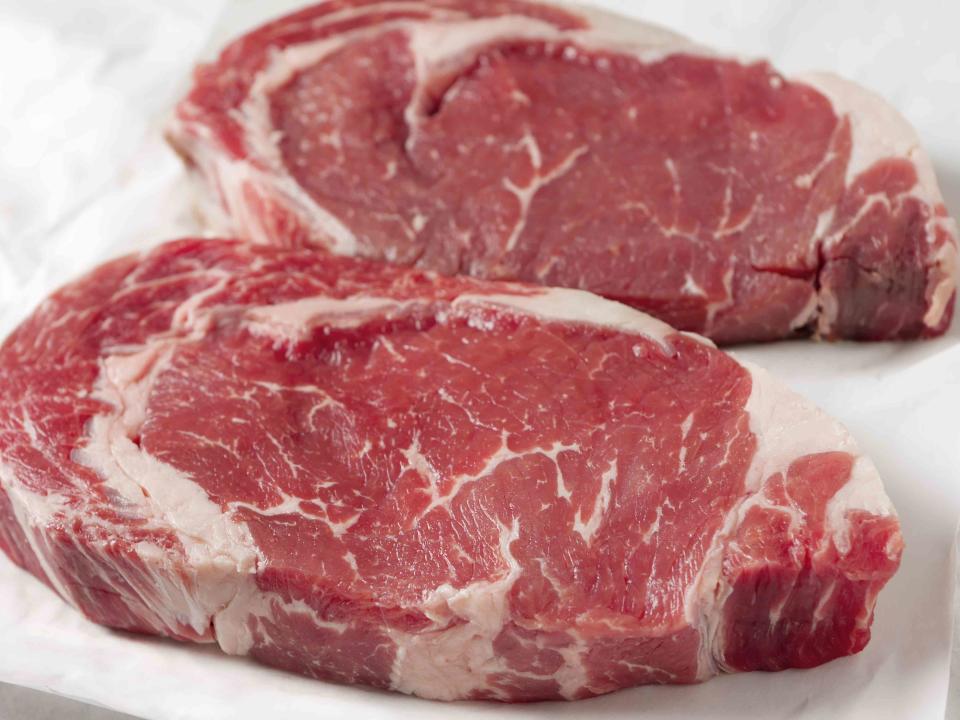Sirloin vs. Ribeye: What's the Difference and Which Is Better?
There’s no doubt, navigating the meat counter can be a daunting task. Here’s what you need to know about these two popular cuts of beef.

boblin/Getty Images
Sirloin and ribeye — two words listed frequently in grocery stores, on menus, and on cooking shows. In fact, these two steaks are often pitted against each other in a kind of battle royale of deliciousness. Truthfully, they are both wonderful cuts of meat that, when cooked with care, are juicy, tender, and deliver big for your beefy craving.
But which one should you go for? Is one cut really superior to the other?
Related:The Basic Cuts of Beef Every Cook Should Know
What Is a Ribeye Steak?
Ribeye, as the name suggests, comes from the rib section (ribs nine through eleven, to be exact) of the cow. Once cut, the rib bone remains attached (hence the name bone-in ribeye) bringing with it a good amount of fat from the ribs. This bone is then sometimes removed.
This cut is known for its marbling — the rivers of white, succulent fat running through the meat that break down when cooked, yielding unruly amounts of rich flavor and palate-pleasing tenderness. This is what makes the ribeye so popular, especially for steak enthusiasts dining out.
Related:https://www.allrecipes.com/gallery/favorite-steak-marinade-recipes/
This center rib section of the animal where the ribeye cut comes from doesn't see much activity during the animal's life, resulting in the beautiful marbling and tender nature it's known for. Ribeye might also be called Delmonico, Spencer, beauty steak, Scotch filet, or even prime rib, which is what you would have if, instead of slicing through the ribs individually, you left the whole bit together as one large roast.
Ribeye Steak Recipes to Try:
What Is a Sirloin Steak?
Sirloin can get a little confusing, because many different steaks come from this large cut, located behind the ribs but in front of the rump. Such well-known favorites like T-Bone, strip steaks (New York, Kansas City, Omaha), and club steak, as well as roasts like tri-tip, all come from here.
These cuts are leaner than the ribeye, without the same degree of marbling, making them a little less tender and a bit milder. That said, cuts from the top sirloin (T-Bone, strips, etc.) still pack a meaty punch, and their signature chew is flavorful without being tough, pleasing steak aficionados everywhere.
Related:15 Delicious Ways to Use up Leftover Steak
Bottom sirloin might not be sliced up for individual steaks, but the lean, flavorful roasts like tri-tip are excellent when slow-roasted, making a hearty meal for everyone at the table.
Sirloin Steak Recipes to Try:
The Verdict
Inevitably, ruling which cut of beef is better is purely personal preference. When you consider flavor, texture, and fat content, whatever reigns supreme in your heart will make your choice for you.
For the most beefy flavor and melt-in-your-mouth texture, go with a ribeye. Ribeyes also cook faster, on the grill or in a pan, which can come in handy. If you prefer to go lighter on the fat content, have a little more time to cook your steak, or are slicing the meat for a dish — like for breakfast with eggs or in a sandwich — select the sirloin. Sirloin tends to be a few dollars less per pound as well, delivering a satisfying steak meal while being easier on the wallet.
Related:8 Different Types of Steak and How to Cook Them
Dry-aging is a technique commonly used to increase flavor and skyrocket tenderness, so a ribeye prepared in this way is a guaranteed hit and a sirloin prepared this way will mean all the flavor of a ribeye without the fat. For some, that means the best of both worlds. No matter your preference, if something boasts dry-aging, you can't go wrong.

